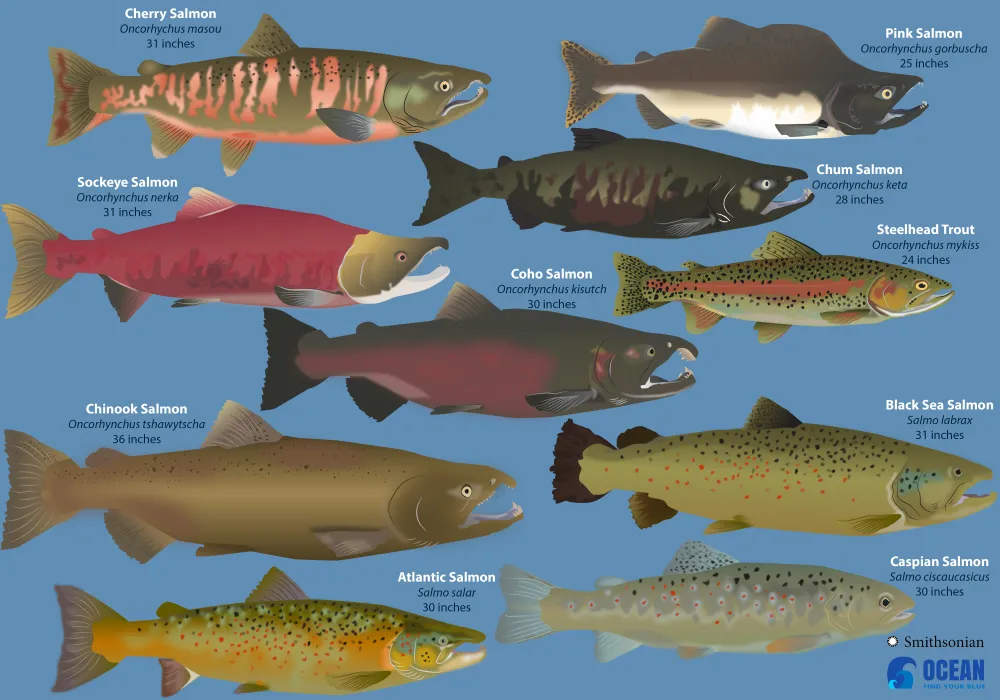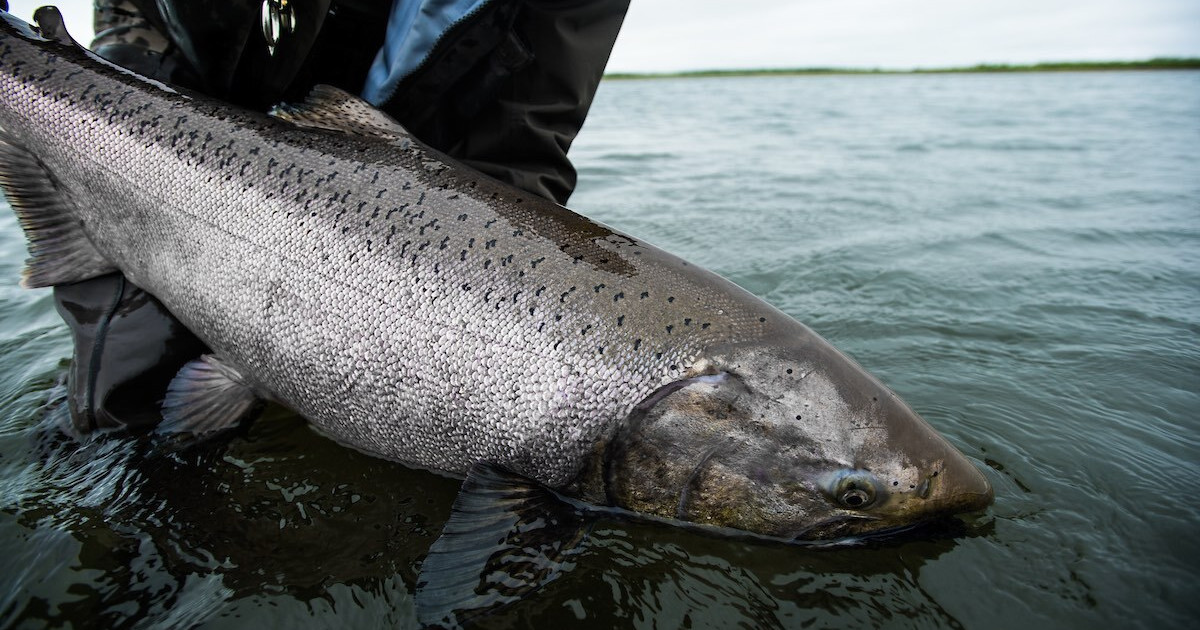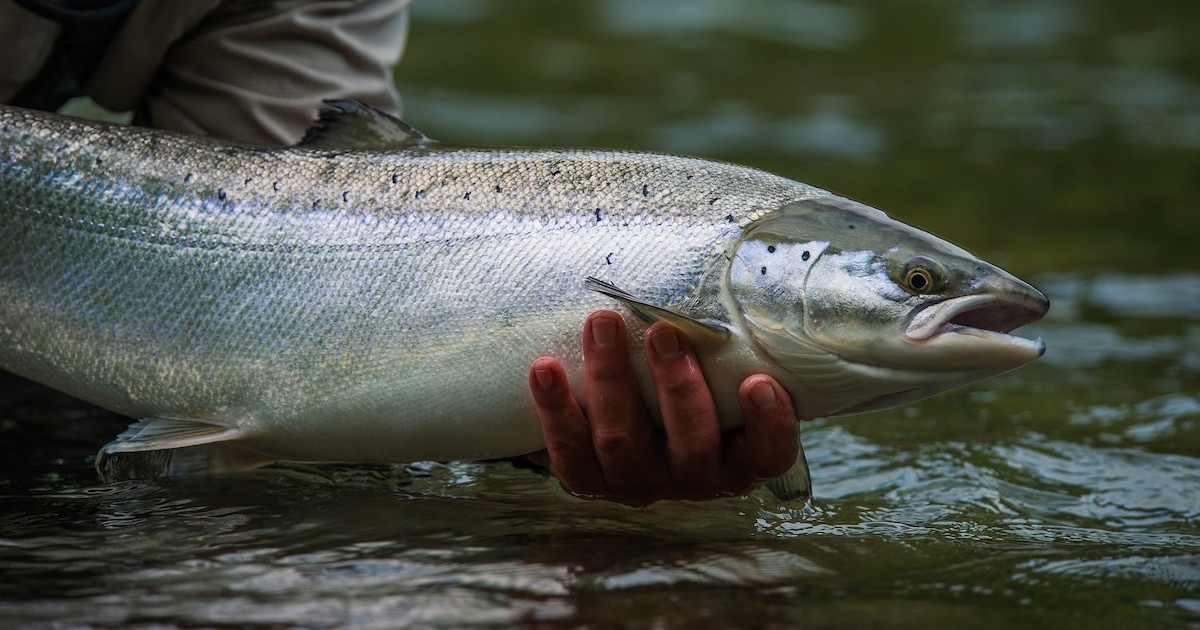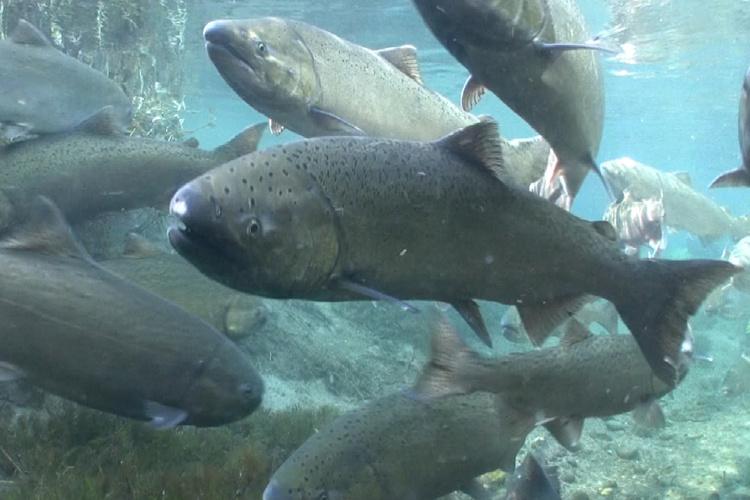Introduction

The world of seafood is home to a variety of flavorful and nutritious options, and none are more celebrated than the illustrious salmon. But did you know that not all salmon are the same? In fact, there are two main types of salmon dominating the seafood industry: Atlantic Salmon and Pacific Salmon. Each type has its own distinct characteristics, flavors, and fishing methods. In this article, we will delve into the differences between Atlantic and Pacific Salmon, exploring their physical appearance, flavor profiles, fishing techniques, and environmental impacts. So, grab a seat and get ready to dive into the tale of these two amazing sea creatures.
Introduction To Atlantic Salmon And Pacific Salmon
Atlantic Salmon and Pacific Salmon are two distinct types of fish that are highly regarded in the seafood industry. Atlantic Salmon, also known as Salmo salar, is native to the rivers and oceans of the North Atlantic, including countries like Norway, Canada, and Ireland. On the other hand, Pacific Salmon, which includes various species such as Chinook, Sockeye, and Coho, can be found in the North Pacific Ocean, from Alaska down to California. Both types of salmon are known for their vibrant colors, rich flavors, and high nutritional value. They play a significant role in culinary traditions worldwide and are prized for their versatility in cooking. Atlantic Salmon and Pacific Salmon differ not only in their physical appearance but also in their flavor profiles and fishing methods. These unique characteristics make each type of salmon a culinary treasure and a staple in seafood markets around the world.
Brief Overview Of The Significance Of Atlantic And Pacific Salmon In The Seafood Industry
Atlantic and Pacific Salmon hold immense significance in the seafood industry. These fish are highly sought after for their vibrant colors, rich flavors, and high nutritional value. They are a staple in culinary traditions across the globe and are used in a variety of dishes, such as sushi, salads, and smoked preparations. The demand for Atlantic and Pacific Salmon contributes to the economic growth of coastal communities, as fishing and processing these fish provide employment opportunities. Moreover, the sustainability and careful management of salmon populations ensure the continued availability of this valuable seafood resource for future generations.
Atlantic Salmon Characteristics

Atlantic Salmon are known for their unique characteristics that set them apart from other salmon species. They have a beautiful light pink color with white marbling and a soft, delicate texture. The flavor of Atlantic Salmon is mild and buttery, making it a favorite among seafood enthusiasts. These fish have a streamlined body shape and are slightly smaller and thinner compared to their Pacific counterparts. They also possess distinct features such as a small adipose fin and small scales. Atlantic Salmon are highly adaptable and can thrive in both freshwater and saltwater environments, making them a versatile species.
Physical Appearance And Flavor Profile Of Atlantic Salmon
Atlantic Salmon is known for its distinctive physical attributes and delectable flavor. It has a beautiful light pink color with white marbling, giving it an elegant appearance. The texture of Atlantic Salmon is soft and delicate, making each bite a pleasure to savor. Its flavor is mild and buttery, with subtle notes of sweetness. These characteristics make Atlantic Salmon a favorite among seafood enthusiasts. Additionally, the streamlined body shape, small adipose fin, and small scales further distinguish Atlantic Salmon from other species. Its unique combination of color, texture, and flavor make it a sought-after choice for culinary creations.
Environmental Factors Affecting Atlantic Salmon Population
There are several environmental factors that impact the population of Atlantic Salmon. One significant factor is the quality of water in their habitats. Pollution and contaminants can negatively affect their health and reproductive abilities. Another crucial factor is the availability of suitable spawning grounds and migration routes. Dams and other man-made structures can obstruct their natural movement patterns and limit access to spawning areas. Climate change also plays a role, as rising water temperatures can disrupt their breeding cycles and alter their preferred habitats. These factors, combined with overfishing and habitat destruction, pose significant challenges to the population of Atlantic Salmon.
Pacific Salmon Characteristics

Pacific salmon, also known as Oncorhynchus species, have distinct characteristics that set them apart from Atlantic salmon. These fish are known for their rich color and firm flesh, making them highly desirable in the seafood industry. Pacific salmon species include Chinook (also known as King), Sockeye, Coho, Chum, and Pink salmon. Each species has its own unique traits, such as varying sizes and flavors. Pacific salmon are also known for their determination and incredible migration journeys, swimming upstream to their spawning grounds. These characteristics make Pacific salmon a prized catch and a favorite among seafood lovers.
Physical Appearance And Flavor Profile Of Pacific Salmon
Pacific salmon, including Chinook, Sockeye, Coho, Chum, and Pink salmon, have distinct physical characteristics that make them easily recognizable. These fish have a rich, vibrant color ranging from red to pink. They have a robust and firm flesh, making them highly sought after in the culinary world. The flavor of Pacific salmon is often described as rich, buttery, and succulent, with a hint of sweetness. Their strong, distinct flavor profile makes them perfect for grilling, roasting, or smoking. The combination of their vibrant color and delectable taste makes Pacific salmon a favorite among seafood connoisseurs.
Different Species Of Pacific Salmon And Their Unique Traits
Pacific salmon includes different species such as Chinook, Sockeye, Coho, Chum, and Pink salmon, each with their own distinctive traits. Chinook, also known as king salmon, is the largest species, known for its deep red flesh and high oil content. Sockeye salmon, known for its deep red color and rich flavor, is highly prized for its firm texture. Coho salmon, also called silver salmon, has a milder flavor and a medium firmness. Chum salmon, also known as dog salmon, has a lower fat content and a milder flavor. Pink salmon, the smallest of the species, has a delicate flavor and a softer texture. Each species of Pacific salmon offers a unique culinary experience and is cherished for their specific traits.
Atlantic Salmon Fishing Methods

Atlantic salmon fishing involves various methods to catch these prized fish. Traditional methods include rod and reel fishing, where anglers use fishing rods and reels to cast their lines and catch salmon. Another method is fly fishing, which is popular in rivers and streams, where anglers use artificial flies to attract and hook the salmon. Commercial fishing for Atlantic salmon often involves the use of nets, either stationary nets called fish weirs or mobile nets called gillnets. These nets are strategically placed to intercept migrating salmon and ensure a bountiful catch. Sustainable practices in Atlantic salmon fishing industry include implementing fishing quotas, using selective fishing gear, and promoting catch-and-release practices. These methods ensure the preservation of Atlantic salmon populations and the long-term sustainability of the industry.
Traditional Methods Of Catching Atlantic Salmon
Traditional methods of catching Atlantic Salmon involve the use of fishing rods and reels or fly fishing techniques. Anglers use fishing rods and reels to cast their lines into the water and wait for a salmon to bite. This method requires skill and patience as the angler must accurately cast their line and carefully reel in the fish. Fly fishing is another popular method in rivers and streams. Anglers use artificial flies that mimic natural prey to attract and hook the salmon. These traditional methods require knowledge of the salmon’s behavior and habitat, making it a rewarding and challenging experience for anglers.
Sustainable Practices In Atlantic Salmon Fishing Industry
The Atlantic Salmon fishing industry is increasingly adopting sustainable practices to ensure the long-term health and abundance of the species. Many fisheries have implemented strict regulations on catch limits and size restrictions to prevent overfishing. Additionally, there is a growing emphasis on responsible aquaculture practices, such as the use of closed containment systems that prevent the escape of farmed salmon into the wild. These sustainable practices help protect the delicate ecosystem and ensure that future generations can continue to enjoy the delicious and nutritious Atlantic Salmon.
Pacific Salmon Fishing Methods

Pacific salmon are caught using a variety of fishing methods, depending on the species and the fishing location. One common method is trolling, where fishing lines with baited hooks are dragged behind a moving boat. This method allows fishermen to cover a large area and target specific depths where the salmon are known to swim. Another method is gillnetting, where nets are set in the water to catch the salmon as they swim through. This method is often used in commercial fishing operations. Finally, some fishermen use dip nets or fish wheels, which involve manually catching the salmon as they swim upstream during their spawning migration. These fishing methods are carefully regulated to ensure sustainable harvesting of Pacific salmon.
Techniques Used In Catching Pacific Salmon
Pacific salmon are caught using a variety of fishing methods, depending on the species and the fishing location. One common method is trolling, where fishing lines with baited hooks are dragged behind a moving boat. This method allows fishermen to cover a large area and target specific depths where the salmon are known to swim. Another method is gillnetting, where nets are set in the water to catch the salmon as they swim through. This method is often used in commercial fishing operations. Finally, some fishermen use dip nets or fish wheels, which involve manually catching the salmon as they swim upstream during their spawning migration. These fishing methods are carefully regulated to ensure sustainable harvesting of Pacific salmon. [^25^] [^26^]
Environmental Impacts Of Pacific Salmon Fishing Practices
Pacific Salmon fishing practices can have several environmental impacts. One major concern is the potential for overfishing, which can lead to a decline in salmon populations and disrupt the natural balance of ecosystems. Additionally, commercial fishing methods such as gillnetting can unintentionally catch and harm non-target species, known as bycatch. This can include endangered or protected species, causing further damage to the delicate marine ecosystem. It is crucial for fishing industries to adopt sustainable practices and implement strict regulations to minimize the negative environmental impacts of Pacific Salmon fishing. [^27^] [^28^]
Conclusion

In conclusion, the comparison between Atlantic Salmon and Pacific Salmon reveals the unique characteristics and fishing practices associated with each species. While Atlantic Salmon is larger in size and mostly farm-raised due to declining populations, Pacific Salmon is plentiful and widely available as wild-caught seafood. Both types of salmon offer distinct flavors and nutritional benefits, making them popular choices in the culinary world. However, it is essential to ensure sustainable fishing practices to mitigate the environmental impacts on salmon populations and preserve the delicate balance of marine ecosystems. Overall, understanding the differences between Atlantic and Pacific Salmon allows consumers to make informed choices and support sustainable seafood practices.
Comparison Between Atlantic Salmon And Pacific Salmon
Atlantic Salmon and Pacific Salmon have distinct differences that set them apart. Atlantic Salmon is lighter in color and has a softer consistency and milder flavor. In contrast, Pacific Salmon is richer in color with firmer flesh and a stronger flavor. These differences in taste and texture make them suitable for different culinary applications. Additionally, Atlantic Salmon is mostly farm-raised, while Pacific Salmon is available as wild-caught seafood, which affects their availability and pricing. Both types of salmon offer unique characteristics and nutritional benefits, allowing consumers to choose based on their preferences and dietary needs.
Nutritional Value And Culinary Versatility Of Atlantic And Pacific Salmon
Atlantic Salmon and Pacific Salmon are both rich in omega-3 fatty acids, which are essential for brain health and reducing the risk of heart disease. Additionally, they provide a good source of protein, vitamins, and minerals. When it comes to culinary versatility, both types of salmon can be used in a variety of dishes. Atlantic Salmon’s milder flavor and softer texture make it suitable for grilling, roasting, and incorporating in salads. On the other hand, Pacific Salmon’s stronger flavor and firmer flesh make it ideal for smoking, curing, and sushi preparations. Overall, both Atlantic and Pacific Salmon offer a range of nutritional benefits and are incredibly versatile in the kitchen.
FAQ About Atlantic Salmon Vs Pacific: The Tale Of Two Seas’ Catch
Q: What is the main difference between Atlantic and Pacific salmon?
A: The main difference lies in their taste and texture. Atlantic salmon is milder and fattier, while Pacific salmon tends to be more robust and leaner in flavor.
Q: Which species of salmon are typically found in the Atlantic and Pacific oceans?
A: In the Atlantic ocean, you can find primarily Atlantic salmon. In the Pacific ocean, you will find different species such as Chinook (King), Sockeye (Red), Coho (Silver), and Pink (Humpback) salmon.
Q: Are there any nutritional differences between Atlantic and Pacific salmon?
A: Both varieties of salmon are highly nutritious, rich in omega-3 fatty acids, protein, and essential vitamins. However, Atlantic salmon is generally fattier, offering a higher content of omega-3s compared to Pacific salmon.
Q: How do the fishing methods differ between Atlantic and Pacific salmon?
A: Traditional Pacific salmon fishing often employs practices like gillnetting and trolling, while Atlantic salmon farming is prevalent in the aquaculture industry.
Q: Are there sustainability concerns associated with catching Atlantic or Pacific salmon?
A: Yes, there are sustainability concerns for both types of salmon. Overfishing, habitat destruction, and pollution impact wild salmon populations in both oceans. However, sustainable aquaculture practices are being implemented to address these concerns for farmed Atlantic salmon.
Q: Which type of salmon is more widely available in supermarkets and restaurants?
A: Atlantic salmon is typically more widely available in supermarkets due to aquaculture practices. However, in regions close to the Pacific ocean, you are likely to find a variety of Pacific salmon species available in local markets and restaurants.
Q: In terms of price, how do Atlantic and Pacific salmon compare?
A: Generally, Atlantic salmon tends to be more budget-friendly as it is more widely farmed. In contrast, Pacific salmon, especially specific species like Chinook (King) salmon, can be pricier due to limited availability and unique flavor profile.

Duke City Kitchen, known for its fresh, simple, and delicious cuisine, has a rich history deeply rooted in the heart of the local food scene. Since its inception, Duke City Kitchen has been dedicated to providing an exceptional dining experience that celebrates the region’s flavors. Founded by a passionate group of food enthusiasts, Duke City Kitchen opened its doors with the vision of offering a welcoming space where people could gather to enjoy thoughtfully prepared meals made from the finest, locally sourced ingredients. This commitment to quality and community has been a driving force behind Duke City Kitchen’s success.